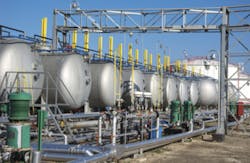The relatively high value of natural gas liquids (NGL) has led producers to increasingly target wet gas, according to a report by the U.S. Energy Information Administration. Liquids extracted from wet natural gas at natural gas processing plants accounted for 5.2 percent of the volume of marketed production in 2013, up from a low of 4.5 percent in 2008. September 2013 represented the highest liquids share of monthly production on record, at 5.5 percent.
NGL prices have traditionally been linked to crude oil, resulting in a significant price premium over pipeline-quality dry natural gas. More recently, the natural gas plant liquids composite spot price (which approximates a value of NGL produced at natural gas processing plants) has hovered roughly halfway between West Texas Intermediate (WTI) crude oil and natural gas spot prices.
READ ALSO: Joint Industry Project Formed to Foster Acceptance of Ultrasonic Flowmeter Technology for Wet Gas
The result of this liquids price premium is that wet natural gas production is increasing at a faster rate than dry natural gas production, the EIA report says. When wet natural gas first comes out of the ground, it contains both methane (which is the primary ingredient of natural gas) and NGL. NGL (ethane, propane, butanes, and natural gasoline) are a subset of hydrocarbon gas liquids (HGL), as they do not include olefins. Between 2008 and 2013, volumes of liquids produced from wet natural gas grew at an average of 7 percent annually, with increases concentrated in the Gulf Coast. Production in the Marcellus region is still relatively small, but is growing rapidly, the report says.
To read this entire report from EIA, go here.


